12 Glorious Marketing Horror Stories
For as long as I can remember, I’ve always loved a good scary movie. Well, maybe not even good ones because I even love the terrible ones (Sharknado anyone?). I don’t know what it is: the panic, the scares around the corner, the scenes that make you jump, the ominous score. Whatever the case, there’s something utterly enjoyable about horror stories. But professionally? Nothing scares me more than some little oversight that ends up going viral or making headlines for being insensitive, offensive, or downright stupid.
Check out this list of my favorite marketing horror stories and the real life nightmares of these popular brands:
1. Heinz QR Code Links to Hardcore Porn Site
 Yikes right? Can you imagine if one of your links or campaigns directed to a porn site? Heinz ran a scannable barcode campaign on limited time bottles, but when the campaign ended, they didn’t renew the connected URL. A clever German purveyor of pornagraphy ended up swooping on that expired URL and directing it to one of their websites.
Yikes right? Can you imagine if one of your links or campaigns directed to a porn site? Heinz ran a scannable barcode campaign on limited time bottles, but when the campaign ended, they didn’t renew the connected URL. A clever German purveyor of pornagraphy ended up swooping on that expired URL and directing it to one of their websites.
2. Bloomingdales Terrible Terrible Terrible Ad
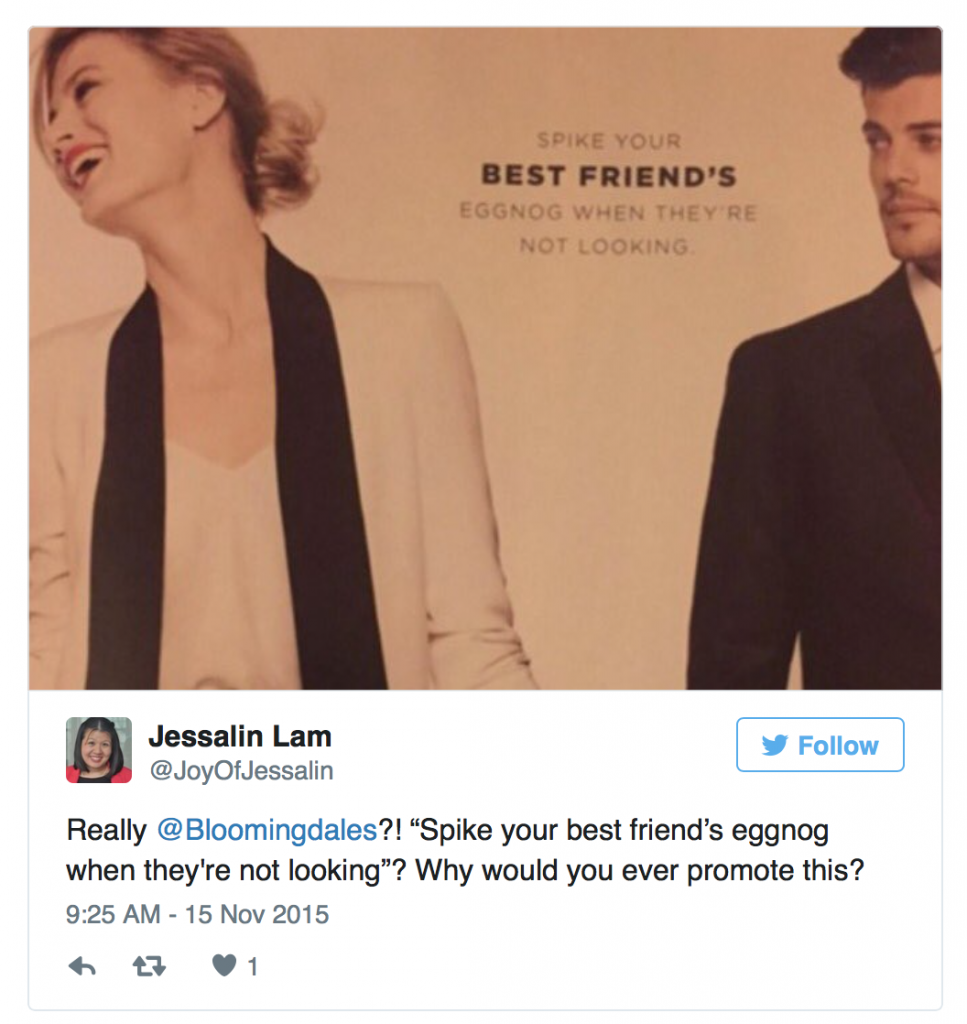 Sometimes I wonder how some ad copy makes it from concept to approval. What group of geniuses sat at a table and thought “I have a great idea for an ad! Let’s have a guy creepily stare at a woman in the advertisement, with the copy 'Spike Your Best Friend’s Eggnog When They’re Not Looking.'" The ad practically endorses alcohol-fueled date rape. Thankfully, Bloomingdale’s was quick to apologize via Twitter, but still I’m left to wonder. Who came up with this and how did it even get put into development? You would think someone would look at this and say “You know what guys? This might not be the message to send to customers."
Sometimes I wonder how some ad copy makes it from concept to approval. What group of geniuses sat at a table and thought “I have a great idea for an ad! Let’s have a guy creepily stare at a woman in the advertisement, with the copy 'Spike Your Best Friend’s Eggnog When They’re Not Looking.'" The ad practically endorses alcohol-fueled date rape. Thankfully, Bloomingdale’s was quick to apologize via Twitter, but still I’m left to wonder. Who came up with this and how did it even get put into development? You would think someone would look at this and say “You know what guys? This might not be the message to send to customers."
3. Bud Light #UpForWhatever
Social media has offered some amazing opportunities for brands to showcase their messaging and personality. It’s also provided us with moments where we think WTF were they thinking? #UpForWhatever is Bud Light’s attempt to create a slogan that promotes carefree spontaneity, adventures, and for removing ‘no’ from your vocabulary at night. Wait what? Yes, Bud Light’s #UpForWhatever slogan encouraged rape culture and promoted reckless drinking. When alcohol fueled date rape is an increasing concern across college campuses, you have to wonder how some of these ideas make it past the concept stage.
4. When Beyonce Drops Your Name and in response you have… nothing

“When he f—k me good I take his ass to Red Lobster“ Those were the lyrics that Beyonce dropped in her song Formation. And in response Red Lobster had nothing. They made the mistake of not responding in a timely fashion, and then by responding with this gem:"Cheddar Bey Biscuits" has a nice ring to it, don't you think? #Formation @Beyonce
And more responses like these:


Missing out on an opportunity is almost as bad as creating a terrible ad. I mean what are the chances of lightening striking twice right?
5. Walmart and the “Fat Girl Costumes"
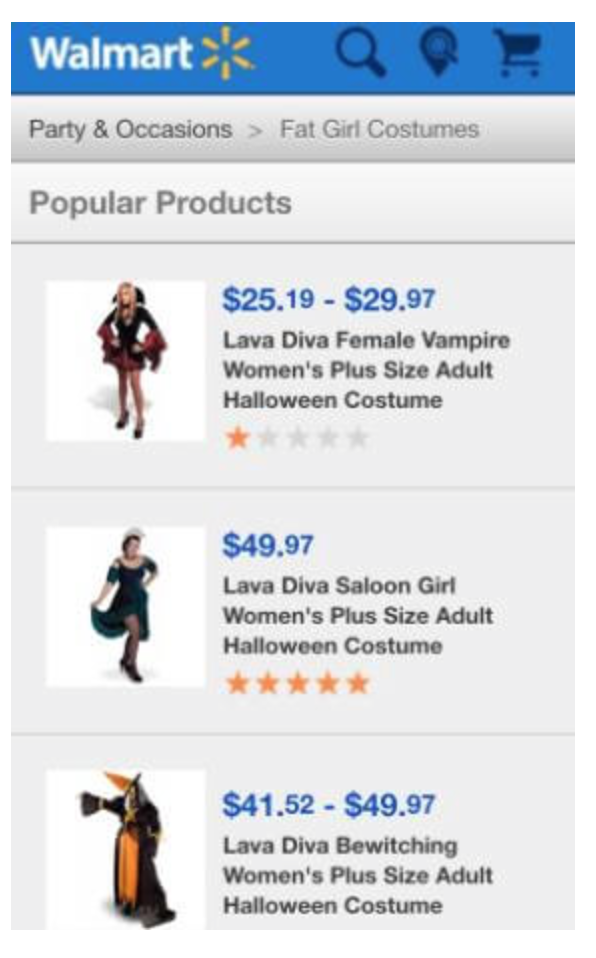
Ay-yi-yi.
I can only imagine one of Walmart’s SEO people sitting there thinking, "We have to name these 'fat girl costumes' because it’s the most popular search term and brings x% more traffic than competing terms." This little gaff is why SEO specialists should sometimes sacrifice the bump in traffic for a more friendly term.
6. Starbucks Race Together campaign

Despite their good intentions, Starbucks encouraged customers to engage in discussion about race relations with baristas. I’m not sure if 16 year old baristas are the best representatives of the Starbucks brand to discuss the hot topic of race relations, and this is definitely an issue that falls under the category of “too hot” to address in this manner.
7. #McDStories
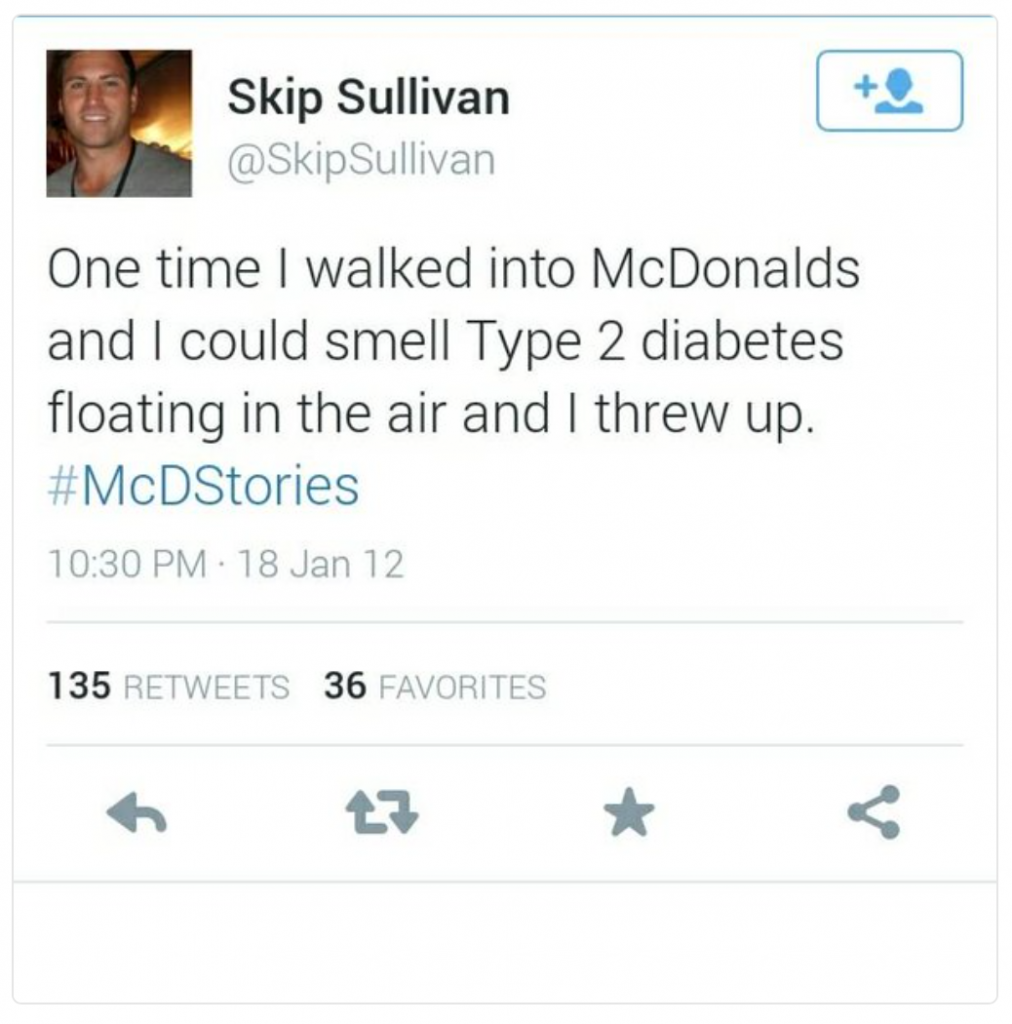
Hehe. The #McDstories hashtag may have seemed like a great idea — Promote positive stories about your brand. The problem here is that those people who were thinking of this campaign probably really really love working at McDonald’s and are detached from how consumers truly feel about their brand. This hashtag was just a recipe for hilarious disaster.
7. Apple Replaces Google Maps | U2 Album
I had to lump these two Apple failures into a single item. The forced “MApples” conversion from Google maps. There were tons of stories such as a user following Apple Map directions into the middle of a natural park. I’ve even had my share of Apple map directions lead me completely astray. The other Apple fail — forcing every single user to download the new U2 album. It’s one thing to offer a free album, but forcing an album onto users devices was some next-level stuff.
8. Seoul Secret

Race is always a touchy subject, but when a company compares light and dark skin… yikes. Seoul Secret, a beauty brand created a campaign called “White makes you win,” promoting a skin-lightening cosmetics line. It’s at this point that I should stop writing because let’s be honest, this clearly doesn’t get any better. Long story short, Seoul Secret tweeted out the campaign along with a video of actress and singer Chris Horwang talking about how her white skin helped her become more successful. Obviously this was not well received.
9. The National Republican Senatorial Committee Bashes a Candidate

Political muck-slinging isn’t anything new, but when the GOP decided to tweet saying that Tammy Duckworth doesn’t “stand up” for vets that’s when things went wrong. 1) Duckworth actually lost her legs while serving in Iraq. 2) She came back to work as the assistant secretary in the Department of Veteran Affairs. 3) The tweet was posted on International Women’s Day. I think it’s safe to say they hit the trifecta on this one.
10. Microsoft AI Twitter bot that went awry...

There’s a famous saying that goes “this is why we can’t have nice things.”Microsoft created an “AI” twitter bot that would learn from users based on conversations. This could have been huge in terms of lowering marketing overhead and increasing real-time response rates. How could something this awesome go wrong? In less than a day, several trolls managed to turn Microsoft’s Twitter bot into a huge racist douche.
11. #AskSeaWorld Campaign
After the hot release of the 2013 documentary “Blackfish”, what could go wrong with a good ‘ol hashtag campaign by SeaWorld that encourages users to ask questions about whale care? The only thing worse was SeaWorld’s responses to these users by calling them “Trolls” among other things.
12. Amazon’s “The Man In The High Castle”

If you’ve seen “The Man in the High Castle”, then you know it’s a great show about an alternate reality where Nazi Germany and Japan won World War II. In terms of promotion, Amazon could have gone the basic route of putting up posters, online ads, etc. Instead they went for a shock and awe approach. They covered New York City subways —sets, walls, and ceilings — with Nazi and Imperial Japanese imagery. Considering the largest Jewish population in the United States is New York City, this may not have been the best idea.
In fact, Mayor De Blasio called the ads “irresponsible and offensive to World War II and Holocaust survivors, their families, and countless other New Yorkers.”
Channel Marketing Email Templates
Building an effective channel marketing program takes a lot of work. One of the most important areas is recruiting reseller partners. But how do you do this?
One of the easiest ways to do this is through email marketing.
There's a lot of bad information out there. People will recommend using "Re:" in the subject line, or tell prospects they missed "meetings". Yes, some people have found success using these tactics, but I think it hurts your brand more than anything. Also, keep in mind that Open Rates are one of the worst metrics to measure campaign success.
Here's why. Just because you tricked some folks into opening your email, doesn't mean it will translate into valuable impressions or new business. I find that learning which contacts opened based on relevant subject lines and then segmenting them based on that is the best way to go. But we can get into list segmentation and advanced campaigns later.
We're going to start with some simple emails. These emails are structured from some that are over 10 years old, and we're going to give them a slight upgrade.
Channel Marketing Partner Email Templates
The first email is a long and informative email. We provide some opportunities to click through and learn more, but the real hot zone is if they open. It's very specific, so opens will immediately be designated as warm.
Subject Line: [Product] Partner Program- Free 5 user subscription
I am contacting you to see if you would like to apply to become an early reseller partner for [Product]. [Product] is the undisputed price/performance leader in the [software type and industry].
Get a Free copy!
To get your attention, I'm offering you a Free five-user copy of [Product] ($$$ value) so you can check it out and use it internally for your own projects. See below for details on how to get your copy.
What makes [Product] so unique?
PROBLEM
The [software indsutry] has over [X] competitors. However, most are [insert sentence that differentiates you from your competitors].
[Insert positive sentence about your product and the differentiator above..]
However, [insert sentence about problems with other platforms UI, functionality, specific features, cost, implementation time, etc.].
SOLUTION
That's where [Product] comes in.
[Insert 3 main benefits below]
1) First, it is a highly competitive high-end, integrated enterprise application (see the competitive matrix).
2) Second, it is much, much easier to use (with a much more modern interface).
3) It is quick to implement (taking hours and days, not weeks and months).
As a result, it has beat out [ insert competitor examples] again and again in competitive bids—especially if the organization has a chance to test it prior to purchase.
Why become a reseller?
First, you'll make good money and get great support. We have a highly competitive reseller program. Here's what you'll get:
- Healthy margins
- Extra margins for your first 90 days (to help subsidize your efforts to learn)
- Pre-qualified sales leads (someone has to close these deals—it might as well be you)
- Deal registration with discounts
- Help with product demos (via Webinar, joint calls (but it remains your account))
- No cost for product and market training, or for internal use
- Opportunities for joint promotions with MDF--plus help setting up promotions
- Plus more…
What's Holding You Back?
See [URL] for additional information or to apply as a partner. Complete the partner application and you'll receive an email with instructions to sign in for your own 5 user copy of [Product] at no cost. I'll then be in touch regarding your application, and then take you through an orientation and get you going.
Please feel free to apply, or call or email me ASAP if you like what you see, and/or have any questions.
Pretty long right? Surprisingly, I've seen quite a bit of success coming from that same email format -- and that's dating back at least 10 years.
Just for kicks, we'll provide templates here for 3 emails and a fourth introductory/congratulations email.
Here's a template for the followup email.
Subject Line: about the partnership program...
Sent you an email last week regarding our partnership program. [Product name] is the [insert sentence that's a highlight of your product].
I think it'd be a good fit based on your customer base and would be a great value-add. You can find the details to the program here. Are you free to talk this week?
The reason we go shorter is because they opened the initial email and (hopefully) read it. We just want to reiterate our channel program and we provide a link so that they can click to learn more. If they click, it's most likely because they remember your offering or are highly interested.
If they don't respond then you'll followup with this email.
Remember gentle persistence is key. We're trying to win people over, not piss them off.
Subject Line: (product) partner program -more info?
Figured you might want some more info about (product) partner program.
We've seen other (insert prospect company type) be really successful for the following reasons.
Perk 1
Perk 2
Perk 3
You can learn more about the program here. Let me know if you're free to talk this week.
By reiterating the perks here you're trying to make the decision obvious to sign up. Such as there are no costs to them, no risks, it's an opportunity to Whitelabel and upsell services, tremendous value for clients, margins, etc.
We want to see them either raise their hand with a click through or respond back. I normally see a high percentage of positive responses by email 3 for people who open the initial emails.
Say they responded to one of the three emails saying "yes" they're interested.
Then, you'll engage through phone and email until they sign up for the reseller/channel program.
At this point, you hit them with the introductory email.
Subject: Welcome to [Product] Partner Program!
Congratulations! I’ve reviewed your application and I think that you’ll be a good fit for our partner program. Next, we need to schedule a meeting to go over the following steps:
Orientation. A quick walkthrough of our partner portal and program, and where we will discuss the margins and different levels as well as how to place an order.
Product Demo. This is a quick demonstration of [Product]. Where you will learn why [insert differentiators]
First 90 day goals. Discuss 3 things that we will do proactively to help promote the product each month. Plus, I'll discuss the 90-day promo where you will earn extra margin (to compensate for the time to get up to speed).
Please e-mail me with some times that will work for you and we'll get going!
If at any time you have any questions, feel free to contact me.
Thank you for partnering with [Company Name].
Why Your Content Marketing Programs Fail
By now you've heard of Content Marketing programs and know of the value behind those programs — to increase web traffic and magically make your business money. The problem with online content marketing is that businesses either still operate under old school SEO principles, or they’re just shooting in the dark. Let’s take a look at why content marketing programs fail, and what you can do to create a strategy that takes your traffic from Barry Allen to Flash (5 points if you understand this comic book nerdism).
Bad Content Marketing
What is bad content marketing? My initial thoughts on bad content marketing are old school SEO guided articles. On occasion you’ll still find these gracing some top spots in Google, but they’re on their way out. You can recognize these old school SEO articles by their robotic language, ridiculous use of specific keywords in every heading and paragraph, and no regards for entertainment or real value. My personal favorites are the ones that are clearly written by non-native english speakers, and the ones that are being optimized for misspelled keywords. Yes, I would love to learn the “10 Best Ways to Increase My PCP Marketing.” By the way, I’m very excited to see all of the great “PCP Marketing” traffic that reaches this page from the inclusion of that keyword. Here's one more instance of "PCP Marketing" just for fun ;)
Other examples of bad content marketing strategies are either not having a plan in place or siloing your content to only one specific niche area. The latter was also very popular in the “SEO glory days,” and is still commonly used. I do my best to urge businesses to think outside of their bubble. An example of creating a silo is writing purely about a single topic. Just because you provide Cybersecurity Services, does’t mean every single article you write has to be about cybersecurity. Other SEO and content marketing experts may argue against me, but hey, different strokes for different folks.
Here’s why I urge businesses to break outside of their bubble. As an individual, I may be interested in a topic like Ghost Busting, but it would be a mistake for a Ghost Busting application to only write about that one concept. Why? Because I have other interests as well. One day I may be interested in learning about Ghost Busting best practices, the next how effectively drop kick goblins, and the next I may be interested in puppies wearing funny costumes. People are infinitely complex and so are their interests. Creating a more broad range of content allows you to keep your audience engaged with fresh ideas, to branch out and build audiences across different areas, and build a more effective lead acquisition funnel.
This is where I see content marketing strategies fail. They choose product or service specific keywords with high volume and saturate their website and article content with numerous instances of variations of those keywords. What happens is 1) keyword cannibalization and 2) failing to properly reach targets at various stages of the sales cycle.
The goal of your content marketing program isn’t just to create badass content, but to reach prospects at each phase of the sales cycle to properly nurture and guide them from initial interest to purchase.
Creating a Good Content Marketing Plan
The first step to creating a good content marketing plan is to understand the sales and marketing cycle. If you Google this, there will be a few different iterations, but for the sake of this example we’ll go with the simplest which is: Awareness, Evaluation, Purchase.
I like to think of Awareness at a very broad level, as a basic introduction to your brand. Here you’ll typically use blog posts, how-to content, and more fun, basic, top-level content. If you provide Ghost Busting software, then here you would create blog posts such as “Most Haunted Places in America,” or “Blair Witch: Fact or Fiction,” or even “Top 57 Movies About Ghosts.” You get the idea.
The next phase is the Evaluation stage. This is where I like to create content regarding various Pain Points, examples of how businesses solved similar problems, information on products/services, and the occasional article regarding competitors. Again, using the ghost busting software example, I’d create content such as: “75 Signs Your Home is Haunted,” or “How Family X Solved the Real Life Case of Annabelle,” or “How Families are Benefiting From Different Ghost Busting Solutions," or “The Proper Way to Make Contact with a Ouija Board.” The content starts to assert that the prospect has a problem with a haunting or a ghost and will eventually purchase Ghost Busting software, but first, you’re helping them understand that they have a problem.
Finally, we get to the Purchase stage. This is where you tie content directly towards purchasing behavior. Here create content based around purchasing your software. Examples would include: “Something Strange is in your Neighborhood... Who you Gonna Call?” or “Tips for Buying Ghost Busting Software,” or “See Our Ghost Busting Software in Action,” or “How The Meyers Family Got rid of their Ammityville Horror With Our App in 5 Days.” You get the idea.
Using SEO in Your Content Marketing Program
Once you’ve put your purchase funnel together and have a general idea of the content you want to create for each stage, then you should start thinking about SEO. This is a pretty major step because it will help you prioritize your content creation based on estimated traffic volume.
Typically, I’ll look at competitors and see what keywords they’re using in titles and content, and then I’ll also use Google Adwords to start building out preliminary keywords lists based on my own ideas. As you search, you’ll start to get an understanding of what people are searching for and their interests. Use your initial list of keywords to create categories for each stage of the lifecycle or "buyer's journey."
For example, in the Awareness stage you may find that "Haunted Places” is a highly trafficked keyword that you use in your category. Under this category you may want to build out various content to support this category such as “Haunted Houses of the West Coast,” or “Haunted Amusement Parks and Why You Should Avoid Them,” and “5 Most Haunted Hotels.” You’ll also want to build upon this keyword category by using Semantic Search for additional SEO.
Using Semantic Search for Content Marketing
What is semantic search? In simple terms it’s a search engines way of trying to provide you with greater accuracy to your search by understanding intent and contextual meaning. Not simple enough? You know when you Google something, and it tries to fill in the blanks or guess what you’re typing by providing other results? That’s it.
However, this is a very useful tool as you build out the various articles that will be part of your content marketing plan. Let's go back to my example of “Haunted Places,” in the awareness stage. I would type that in to Google and see what my top results are, which would be “Haunted Places in Texas,” “Haunted Places in Austin,” “Haunted Places Near Me,” “Haunted Places in Lubbock,” and “Haunted Places in San Antonio.” I’m located in Texas in case you haven’t figured that out ???? If Google is recommending these as popular search queries, then I know that providing location-centered content to support these would be beneficial for my content marketing strategy because other people out there are searching for the same exact thing.
It can get tedious, I know, but building a content marketing program is a strategic effort. As I mentioned earlier, when content marketing programs fail, it’s because of poor planning or not properly addressing the sales funnel with a broad range of content to attack each stage of the buying cycle. The goal of your content is to ultimately drive revenue and it’s time you start putting together a strategy that works. Do your research, make your plan, then create content that engages your readers and provides value to them at different stages of the buying cycle.
Most Toxic Work Environments in Game of Thrones
We’ve all read the stories that talk about various workplace scandals, from office hookups to tales of embezzlement, deviant behavior and corporate backstabbing. These stories have become more common with the rise of the tech industry and the rise of the startup mentality: getting funding and getting it fast. This work hard, party harder mentality has given rise to more and more toxic work environments as both the periods of work and play become more extreme. These days, it’s not uncommon to hear about workplace scandals coming from large corporations such as HubSpot or even Google.
Yeah, Google has problems and lots of them. I believe Google has the ethics of Roose Bolton, plays nice one second and then flays the skin off your bones another. But that’s a rant for another day.
Compared to today’s startups, are there any work environments that are worse? Wallstreet maybe? Well, how about the kingdom of Westeros? Although fictional, Game of Thrones various Kingdom’s give us a look into the worst of the worst.
The Faceless Men of Braavos
This cult of mystic assassins may sound great, but have you ever tried to join a mystical cult of assassins? Neither have I, but I imagine it’s similar to CrossFit or Soulcycle. You have to live and breathe the life, even to the point of being tortured for your “betterment.”No pain, no gain right? I’m sure that’s how new member Arya Stark feels after being blinded and forced to fight in the back alley’s of Braavos. I think the Faceless Men of Braavos could probably write the most horrible employee training manual. Employees will be required to sweep dirty floors, clean bodies, remove faces from bodies, and be blinded and beaten.
Castle Black
Let’s start with Castle Black. I would have once considered Castle Black a fairly decent working environment, not very toxic to say the least. Every member of Castle Black knew his role and worked towards a common goal — defend the wall. But then Winter came, reeked havoc, and broke the hearts of millions of Game of Thrones fans everywhere. When things got tough they couldn’t keep their sh@t together, and they quickly turned and cast blame on each other, ultimately turning on Lord Commander Jon Snow. Literally stabbing him in the back.
The Kingdom of Mereen
Fear change much guys? Of course they do. Daenerys, Queen of Dragons, came in to right the wrongs of this kingdom. Setting free all of the slaves, but was faced with so many toxic members of society that an uprising was inevitable. And you can’t blame her. As a CEO she would have done all the right things. She tried to implement change, she leveraged a key influencer to help aid in the adoption of the new direction of the kingdom, but the one problem she had was never taking care of the cancer that plagued her kingdom. She had toxic citizens on her hands and just like any toxic employees they can spread their toxicity.
House Bolton
Fear. If there’s one thing to be said about the House Bolton it’s that they DGAF. They run their operation through fear and oppression. They’ll commend you for a job well done one second, and then lock you in a cage with the dogs another… or worse (Theon Greyjoy anyone??). When upper management aka Roose Bolton is such a nasty person, what do you think happens to the people who take orders from him? This is a prime example of top down toxicity and I hope to see Roose and Ramsay flayed by a rusty spoon before the end of the series.
King’s Landing
Oh King’s Landing. In such a brief period of time how many different Kings have ruled? What makes this such a toxic environment is the constant backstabbing and detachment from the people. The King and his Hand have no idea what the people really want, and as a result there is constant uproar. They’re basically Comcast. Everyone puts up with them because they have too, but nobody can stand them. From Robert, to Joffrey, to the lame Tommen — none has been capable of properly running the kingdom. I’m sure the people can only hope that Sir Pounce is the next to ascend the throne. The Kings of Westeros also have another fatal flaw — their ability to choose a good team to support them. Whether it’s Lord Varys or Peter Baelish, someone is always working behind the scenes against whoever is sitting on the throne. As King of Westeros you have a 99% chance of dying by ridiculously treacherous means.
Being employed or in charge of one of the Kingdoms of Westerns comes with a single guarantee — that you will work in one of the most toxic environments that is completely lacking in professionalism. Climbing up the Westeros corporate ladder ensures that you’ll end up 6 feet under, but staying still means either being a victim of sexual harassment or being asked to put your life on the line for a King you care nothing about.
Leveraging Modern Day Marketing Principles in Recruiting
As the role of technology in the hiring and recruiting industry continues to grow, it’s only natural that we’ve seen changes to the way people are hiring. The industry really kicked off in 1999 when The Monster Board and Online Career Center merged to become Monster.com. Then, after thousands of job boards had popped up, we saw the birth of applicant tracking systems, job aggregators and pay-per-click job boards. The world of hiring and recruiting has grown dramatically and so has the technology to support it.
It's 2016. It'd be stupid not to look at the state of recruiting and how it relates to marketing. The key word that it all boils down to is “Acquisition.” Customer acquisition and talent acquisition have nearly identical processes, so why are so many still treating them as completely unrelated?
Within the Customer Acquisition process, it all starts with developing marketing campaign content. This means creating everything from ads to press releases, blog posts, white papers and more. This content is then used to generate sales leads, that are ultimately given a score and nurtured until they become a sales qualified lead. This qualification process ensures that the sales team focuses their energy on the hottest leads, and minimizes the time spent trying to cold-sell to a lead that is unqualified or unprepared to make a purchase.
What helped make all of this lead generation campaign and qualification possible? Marketing Automation. Automation helps create a proper workflow to easily manage and automate the tasks necessary to launch and track the progress of leads. Then, through the use of Salesforce Automation tools (SFA/CRM), the sales team is able to manage the pipeline of leads and opportunities up until closure. There are tons of features that help to manage this process such as activity tracking, task management, reporting and more. The cherry on top of the customer acquisition sundae, is being able to generate a Customer Acquisition Cost (CAC) from all of your marketing and sales efforts. This information can show you how to become more efficient at generating leads, lower costs, and where to spend more effort to acquire more customers.
Talent Acquisition as Lead Generation
So, by now, you’re probably thinking, “what the heck does this have to do with hiring and recruiting?”
Well, Talent Acquisition shares a very similar process to the marketing and sales funnel. The one exception being that, instead of trying to generate leads for your sales team to close, you’re trying to generate candidates to hire. When you actually compare both processes the similarities are redonkulous.
Like the Customer Acquisition Funnel, the Talent Acquisition Funnel also begins with content development. These pieces of content even have striking similarities to marketing. You have job ads similar to paid ads, you have your job descriptions which can be SEO optimized for increased visibility, and you have qualifying questions, an employer brand, etc.
One of the most stark similarities between lead and candidate generation, is how job aggregators and job boards have begun to use search algorithms to determine relevancy of specific job posts. This is the same way that search engines like Google and Bing determine what Ads they display and what web pages show up first in results.
While the criteria differ slightly from job boards and search engines, much remains the same. Prevalence is placed on the “Job Title.” The more specific, the better the results on the appropriate searches. Keyword saturation within the job description itself, (the inclusion of the relevant terms used to describe job title, similar titles, skills that people would search, etc.) also plays a pivotal role in gaining relevance. Similar to web SEO, you can leverage associated and tertiary keywords to generate increased traffic.
If you thought things were crazy already, prepare yourself because they're going to get even crazier. Once you launch your job ad across your platform(s) of choice (Monster, Jobs2Careers, Craigslist, Indeed, Sponsored Ads, etc.), you start generating candidates just like you'd be generating leads! Similar to the customer acquisition process, you need to spread your marketing across several channels to generate the best cost/candidate (or in customer acquisition metrics, cost/lead).
But, just like in marketing and sales, you need a way to qualify all of the leads (candidates) that have come through or applied. Once you have hundreds of resumes to review, you need to qualify each applicant to determine if they deserve an initial interview. Currently, in the hiring and recruiting market, there aren't many tools that provide candidate qualification and scoring. Some programs provide a score based solely on keywords being used in resumes, but more capable solutions assess candidates with online interviews and resume analysis to determine a more intelligent score for candidates. Automated candidate scoring lets hiring managers spend less time reviewing resumes and more time focusing on the most qualified candidates. This is just like how marketing automation and lead scoring help sales teams determine where they should focus to close more deals quickly.
The next stage of the talent acquisition funnel is also one that will seem very familiar. This stage consists of the candidate management and interview process steps of the talent funnel. This is tracking the candidates in your funnel and their progress through your interviews all the way to hire. This is where those age-old applicant tracking systems come into play. They help you manage all of your candidates in an online platform and see: who has interviewed, what interviews are coming up, and who has been hired.
What they don’t show you is the data on how effective and efficient your hiring process has been. Three valuable metrics to determine your effectiveness — 1. days to present (how long did it take you to find that qualified candidate), 2. days to accept (how efficient is your interviewing and job offer process), 3. cost per-hire.
Changing the Hiring Game
So, how much did all of your candidate sourcing efforts cost you in the end? Yes, you landed that perfect employee, but did it cost you $100/hire or $10,000/hire? How much internal staff time did this consume? This is also a cost you need to include in your Cost Per Hire (CPH). These types of metrics and data will be the next steps in the hiring industry. In the future, everyone may be using multiple sources to find their hire and assigning costs to create an optimum cost/hire. It’s what’s currently done in marketing to get the lowest overall cost/lead, and will be the next natural step in the hiring process.
“Ok, so the customer acquisition process and talent acquisition process are similar. I get it, but what do I do now?”
Viewing the entire talent acquisition process from a marketing mindset absolutely changes the game. Just by using some basic search engine optimization tricks, you can increase the number of times your Job Ad is listed in the search results on job boards (these are called impressions). Additionally, by applying a more marketing-minded approach to writing your job descriptions, you can even increase engagement and number of applications.
For businesses, A|B testing job descriptions and titles will be one of the next big things to improve talent acquisition. How do you know that the changes you’re making to job descriptions are actually driving more applicants? The answer is running an A|B test and changing small sections so you can measure the improvements you’re making each time you modify a job description for a position.
For example, say you want to hire sales manager for a medical services practice. You can launch an A|B test on job titles for a) “Sales Manager” and b) “Medical Services Sales Manager.” Group A will yield broader results, but may not generate enough qualified candidates. Group B will have a lower volume of applicants, but may have a higher volume of qualified candidates. To achieve even more granular results, you can use this method with job descriptions as well. This is a common practice in conversion rate optimization for landing pages to drive lead generation.
Even using these A|B tests for emails to potential (passive) candidates is possible. If you have a list of passive candidates and you’re trying to land a successful hire, it’s only natural to want to make sure you get the best bang for your buck out of each email campaign. Using general marketing principles here helps you drive more effective campaigns. Add in an eye-popping subject line, some engaging email copy, a call-to-action (ex: “Apply Now”), and you can easily increase your application to conversion rates.
In pay-per-click advertising (think Google Adwords but on job aggregators, like Indeed or ZipRecruiter), one of the common tools used is a conversion optimizer that uses data from each keyword to determine which adgroups and campaigns will lead to the lowest overall cost for leads. Sponsored Ads on Indeed are already using a conversion optimizer to help you get more applicants at a lower cost and remove the headaches of having to manage all of your individual hiring campaigns, but how about applying this on a larger scale?
One of our clients has dubbed this “Smart Job Marketing,” and it plays a key part in their candidate management platform. It takes a similar approach that PPC Management platforms use when optimizing your bids across all active pay-per-click networks to get lowest cost per lead, but applying the principle to hiring. The platform uses an intelligent algorithm, current performance, and historical data to determine which job boards and networks will be most-effective in bringing in qualified candidates. After all, why just post on one job board when you could be posting to several hundred different places at the times where you’re most statistically likely to engage with top candidates?
One of the coolest things I’ve seen pop up is retargeting in the hiring industry. What is retargeting? So, you know when you’re shopping for shoes and then you go to a different website like New York Times and you see a banner ad for the same shoes that you were just looking at? That’s retargeting.
One example of this is Monster.com’s service. They provide retargeting to track users who are a good fit for your position or who have viewed your job description, and target them with ads across their networks and partner websites. In marketing, this has been an effective form of keeping your brand in front of a potential customer. They visited your website and showed interest, but maybe weren’t ready to apply at the time, and so you retarget them with ads to regain their interest and eventually convert them into a paying customer.
Now, taking this aspect of retargeting a little bit further, is hyper-targeting on Facebook. If you understand online marketing, a little lightbulb probably turned on in your head. If not, here’s how it can change the hiring landscape. Passive recruiting tends to involve a recruiter sending emails to or phoning every single qualified person for a job, even if they aren't necessarily looking. If you’re looking for a Java Developer, then your recruiter is probably going around LinkedIn using a Boolean search to pull lists of people to email. What Facebook hyper-targeting allows you to do, is upload a list of contact email addresses and target that list of contacts on Facebook with relevant job ads. This is one of the latest things being tested to help drive more qualified candidates, and we are seeing some surprising results (which I am not able to disclose at this time, sorry). I will say, that from a passive recruiting standpoint, this is something that you will see more of in the hiring industry, as it takes the most popular social media platform and allows you to target a specific audience with highly relevant job ads.
Hiring has, since the existence of hiring and recruiting, been dominated specifically by Human Resource professionals. However, in the near future, we’ll start seeing a more hybrid role of a HR/Marketer. That means either marketing professionals working with HR teams, HR professionals being trained in the multiple arts of online marketing, or the creation of a new position, "HR Marketers," who specialize in testing and launching campaigns to bring in the most qualified candidates. We’re already seeing a shift in the way that the industry is functioning with advances in technology. Some of these new standards include the basic uses of “Keyword Optimization” being applied to writing job descriptions, and HR professionals using Boolean search to capture specific candidates on sources such as LinkedIn.
With the entire hiring industry evolving, it’s time to change the way we think. In marketing, we focus on the end result of acquiring a new customer, and we use as much data as we can to lower the cost of acquiring a new high quality customer (or Cost Per Acquisition). With hiring it’s the same thing. It’s time to stop recruiting. Focus on making a hire, and start thinking like marketers.
We regularly work with tech and B2B businesses in the HR and recruiting space. Click here to learn more about our online marketing for HR and recruiting.
How to Hire Home Healthcare Workers
Hiring home health care workers requires the right people to provide exceptional levels of care and management of patients. Every single day, families are struggling to cope and the attention and care needed for a senior or special needs family member can become too much. So, families seek the help of an organization like yours. One that provides caregivers or nurses for in-home healthcare. This means you need to find employees that are empathetic and exceptional caregivers. But that's easier said than done right?
What’s the best way to find employees for in-home health care?
Have clearly defined roles and qualifications.
For this example, we’ll take a look at how you can find high-quality Caregivers. By establishing early on what their requirements are you can ensure that applicants will understand what their job entails and be able to determine if it’s a good fit for them.
A good example of an opening for a home healthcare job description would be as follows:
You are naturally empathetic and are looking for an opportunity to give something back to elderly people in need. Imagine a career where you can not only craft your own schedule and befriend some of the most interesting people in the area, but also provide a level of personal support that the seniors will embrace. Supporting a small number of seniors, you will become an essential part of their family as a Caregiver with [COMPANY NAME].
You can include more information regarding well developed training programs for topics such as intensive dementia and Alzheimer's, or other training programs that can help them increase their knowledge.
Here's an example of a good intro for a job description:
As a dedicated CAREGiverSM, you can help these families restore balance, order, and peace to their lives and help their loved ones remain at home.
Caring for seniors is a labor of love that requires a special person with just the right touch. That's why, when you provide care with the [COMPANY NAME] network, you become a CAREGiver with a capital "CARE."
Becoming a paid caregiver is a unique job with many joys and rewards, as well as responsibilities and challenges, both physical and emotional. As a [COMPANY NAME] CAREGiver, you'll meet wonderful people, build fulfilling relationships, and make a difference in the lives of your clients.
Screen well and Screen thoroughly
When finding caregivers or other positions for home healthcare, it’s critical that you thoroughly pre-screen candidates. You can do this either through the initial phone screens, or you can cut down on the time you spend calling each applicant with different screening tools.
Screening Questions
Here are some opening questions to pre-screen candidates that we’ve seen are proven in helping to hire excellent caregivers.
Question: Regarding family values and the importance of family, I believe that
Answer: Family connections and an emphasis on supporting family are the most important parts of life
or
having strong family ties are important.
an option to knock out a candidate would be if they responded with: they are nice to have, but not an essential part of life.
What this question does is enable you to determine which applicants truly understand the importance of each family member that they watch over. The more they care the better it is for you and the family that has given you the responsibility of watching over their family members.
Question: I have cared for the following number of seniors over the last 24 months
Answer: Over 6 seniors
Statistically, applicants for caregiver positions who have watched over 6 seniors in 24 months understand the demands of the position better and know how to handle various situations, making them better hires.
However, answers with 2-6 seniors in the last 24 months lead to exceptional hires as well.
Question: My most recent or current level of experience working with senior or elderly population is best described as:
Answer: Substantial involvement with the senior population - I have worked with the elderly or seniors such as in nursing homes, assisted living, in-home care or related health-care settings specifically designed for the elderly
or
Answer: Some involvement with seniors - I have occasionally worked with the elderly or seniors such as in a hospital or clinical setting
Question: Regarding my documentation habits, my colleagues and former supervisors will agree that:
Answer: I am detailed about documenting my client's care, knowing that others may depend on my documentation
You can view the complete list of Initial pre-screening questions that we’ve used to identify great Caregivers here.
In addition, the above initial screening questions, we recommend using open-ended questions to learn more about an applicant's actual experiences, skills or behaviors.
Here are the questions that we’ve found to be a good way to start.
Question 1.
Briefly, tell us about a senior that you have cared for. Give us an example of going above and beyond for that senior.
Question 2.
Please briefly describe a situation where you were able to get a senior to open up to you, even though they were hesitant at first.
Question 3.
What rewards have you received or think you will receive from caregiving?
Question 4.
What would be your ideal work schedule? (nights, days, only a few hours, weekends, 7/24, etc.)
These questions are a great way to determine a caregivers skills and how hard they work to ensure the best care possible. You can either choose to use these types of questions on the phone or with an app like HireMojo you can have all of these questions answered up-front when you receive their resume. You can view complete job descriptions and interview questions for previously filled Caregiver positions here.
Common Mistakes When Buying Association Software
Buying association software is a big decision. Making the wrong choice can cost you hundreds of thousands, even millions! Besides the price tag, there are the implementation costs, the time wasted on ineffective/clunky software and the time that your employees wasted trying to use the program.
If you can select the right association software the first time around, then you can avoid these costs and get the admiration of your employees instead of their 2 week's notice. The right association software for your company will empower your staff to push the limits of their productivity, learn new technologies and learn new ways to improve the way they work.
The wrong software won't do any of that great stuff, which is why you need to avoid these mistakes at all costs:
1. Starting with a Vendor Picklist
Having a good AMS vendor pick list is a good thing right? Yes and no.
It’s great when you’re further in the software selection process, but if the first step you’re taking is by evaluating vendors, then you’re setting yourself up for failure.
2. Using Price as your only Criteria
I’m not saying the price isn’t important, but, as they say, you get what you pay for. You may not need the fully upgraded package, but it's still a mistake to pass on an AMS solely because it’s a few thousand more than you expected to pay.
You're making an investment in the effectiveness of your staff, so you need to choose the solution that will solve/automate most of your staff needs while giving your members more value for their time. If you want that ROI, then you need to give your people the tools that they need.
At the end of the day, choosing a solution that costs less will inevitably mean you’ll have to go back to the market and repeat the entire AMS software selection process all over again.
3. Not Involving all Stakeholders
Maybe you’re excited to spearhead the software selection process, but the whole project can go belly-up if you don’t involve all key stakeholders.
Make sure during the process that you involve your board, executive director, membership manager, accounting team, and even get feedback from a couple of key members. If you can have key members try the software, all the better. Involving all stakeholders is a best practice to make sure no members show up on your doorstep carrying pitchforks and torches. It will also make it easier to get funding approved when key members have hands-on experience with your proposed AMS.
If you can involve all stakeholders in the selection and adoption process, the whole AMS selection and adoption process will run much more smoothly.
4. Trusting your IT Department too Much
Don’t get me wrong, definitely, involve your IT people in the process. However, do not let them make the final decision or fool you into thinking that you can have the vendor scrap certain customizations because they can build it themselves. The last thing you need is
1) your IT people won’t be the core users of the software, and won’t be engaging with it on a daily basis.
2) They most likely will not have access or familiarity with the software or have the time to make the customizations that you need.
5. Avoiding the Cloud
I don’t know why, but some people still do not want software that exists in the cloud.
Cloud software lowers your tech overhead costs because there’s no server-side installs and vendors automatically update the platform with each new release. This ensures that you’re not stuck with an outdated platform like AMS Version 10 when they’re on AMS Version 250.
6. Falling in Love with Flashy Features
You’re buying an AMS to help solve specific problems. A common mistake that associations make is focusing on a single flashy feature rather than the overall functionality of the AMS.
Don’t get carried away or make decisions based on a certain flashy feature. Instead, focus on functionality: the holistic often “unsexy” features that will help your staff better conduct their day-to-day operations.
7. Not Identifying the Pain Points You Want to Solve
Before you start addressing features, you need to understand what problems you’re currently experiencing.
- Are you experiencing pains with regards to managing member lists and groups?
- Is billing a hassle for your team?
- Does reporting take too long?
- Are your members not engaging?
Whatever your pains make sure to create a list. This will help you stay focused when picking software that is right for your association.
8. Choosing What you Want not What you Need
Once you’ve identified your pain points, then you need to find an AMS with the features to fully address those needs.
Create a list of must-have features that will solve your pain points. This ensures that you don’t get blinded flashy or unnecessary features, and having a list of clearly defined needs will go a long way in lowering your overall costs. You’ll be able to tell vendors what you need, and avoid getting up-sold on unnecessary items.
9. Putting your Decision off for too Long
I’m not saying rush into any decision. However, the decision-making process can often take a long time — especially with board approval, involving other stakeholders, etc.
Do your best to streamline the process by establishing clear goals, pain points, and need lists. Then, create a list of vendors and go through the sale process with them. Once you tell them exactly what you want, then you’ll be able to determine which vendor is right for you.
Finding the right vendor already takes a considerable amount of effort, and once you find them odds are you’re going to choose them. So, why put off the inevitable? Delaying a decision will ultimately cost your association more in terms of lost productivity.
10. Not Tracking Results
You should always track the effectiveness of whichever Association Software you end up choosing for your company.
Track the progress of employees in learning programs, record the productivity boosts that result in process automation and, most of all, track how much value your members are finding in your AMS. You're investing in the effectiveness of your employees, so track the ROI that your Association software is bringing to your employees and your company. If it turns out that a software isn't actually the magic bullet it seemed to be, tracking ROI from the beginning will ensure less time is invested in the dud program.
Always track the ROI that an AMS brings to your company.
Choosing association software is a big decision, one that involves people from the board to staff, to other members. Making a mistake during the AMS selection process can be costly and time-consuming, and if you use these tips as a guideline, you’ll increase your chances of success. Always understand your needs before you choose a software and always track its ROI so that you can be sure you're getting your money's worth.
Using Cheat Codes to Level Up Your Email Marketing List
To buy a list or to build a list? That is the startup question.
Traditionally, marketers have gone the route of buying a list, and why not. It saves time, it lets you attribute ROI directly to a specific cost, but, most of all, it’s easy. Hell, if I could buy a list and get the same level of engagement as 2011, then I’d do it in a heartbeat.
But alas, times have changed. Most of the time, buying a list results in 10% open rates with very little engagement. It’s like taking a literal shot in the dark. Sometimes you hit, but most of the time you miss. You also end up pissing a lot of people off throughout the process. Regardless of what you hear these days, if you want long-term success, then you need to build an organic email list. The best way to do this, is by using a content-driven strategy as the backbone.
You’re probably thinking “Aww shucks, ANOTHER article about content marketing.”
Sorry to disappoint you, but it’s not.
Leveling up your marketing means looking at marketing holistically, instead of silo-ing every different area into it’s own department. After all, the way I see things, a marketers goal is to help people find a solution to their problems (even if they’re not aware that a problem exists). SEO, email, social media, content, paid advertising — they’re all tools that help us reach that goal.
Build An Email Marketing List Organically
Now, let’s get to the fun part. How do you build an email marketing list organically? When you load your email marketing platform (Mailchimp, Constant Contact, or whatever you’re using) start by typing: Up, up, down, down, left, right, left, right, B, A. (Gamer Five!)
Did it work? If only things were that simple, right?
Unfortunately that old cheat code won’t work. Luckily for you, there are plenty of other ways you can level up your organic email marketing list. Here’s the play-by-play.
- Get the Right tools.
For every startup or growing business, I always recommend having at least two tools to work with your website:
1) Email Marketing
and
2) SumoMe.
For email marketing, I’ll always recommend Mailchimp as a starting point. It’s simple, easy-to-use, can handle: semi-complex workflows, automated processes, and nurture campaigns. It also easily integrates with several other tools you may or may not use as your business grows.
The next tool that I use is SumoMe. They have a suite of tools for list building that I think are incredible for small and growing businesses, and it integrates directly with Mailchimp — Creating a nice 1-2 punch that can be an absolute knockout when used correctly. If you don’t like Mailchimp or have some other preference for email marketing tools, then don’t worry because SumoMe probably works with those too.
Now, the other reason why I opt for these two solutions is because, when used correctly, you can automate most of your marketing processes. This is crucial with small and growing businesses. Automation allows you to focus your efforts elsewhere, while you create a steady lead and opportunity pipeline. And that’s the goal right? To level up your list building with as little effort as possible.
- Build Content
Content is an extremely vague term. Content can be white papers, guides or how-to’s. Content can also be an image, an infographic, a blog post, an article, or any other bit of media that can be understood and enjoyed by your potential customers.
So, what do I mean when I say content? I mean something that your audience finds valuable, interesting or worthwhile. You can use this stuff in multiple ways, but the way in which you use it should always be based on your audience. So, just like you’re investing specific tools, you’ll need to invest time into creating some fairly awesome or useful content.
What content should I build for best results?
I wish I had an answer for you there, but until you've built it, you won’t know.
Every brand attracts a different audience. Maybe the people visiting your website are Walking Dead aficionados, or maybe they’re more about the Kardashians. You won’t know until you start gathering some intel on the people you're targeting. To start though, I always like to keep things simple. Keep things relevant and keep things interesting.
For example, If you’re providing software to help improve office productivity, then you may create a list or guide called:
- “67 Badass Ways to Increase Office Productivity," or
- "The Definitive Guide to Get Employees off their Butts and Get Work Done,” or even
- “Turning the Walking Dead into Your Competitors Dread.”
Possibilities are pretty endless here. A common trick of the trade that you’ll see out there, is using random numbers like “67 ways”, “138 tips”, etc, for your listed content. The reason, is because it stands out more than those other "Top 5" or "Top 10" lists that are plaguing the internet like a deadly mist. Also, make sure that your piece of content aims at solving some sort of problem you think your prospects may be experiencing. Could be productivity, could be office hygiene, whatever will help your prospect conclude that you are a good source of information and a potential solution to their problem.
Next, I’ll get into how you can mushroom your list from a tiny mario to a Super Mario!
- Content. Now what?
Now, it’s time to level up your organic email list building. You’ll want to have your awesome guide (I’m going to use "67 Badass Ways to Increase Office Productivity”) converted into a PDF.
Next, we’re going to go into MailChimp (or whatever your email service provider is), and create a list called “67 Badass Ways to Increase Office Productivity (or whatever your content is called)." You do this, because all of your contacts that are going to be generated, will need to be added to a list. You’ll want a specific list because, that way, you can create workflows and campaigns based around the fact that they downloaded or signed up to view this piece of content (more on this later).
To start, you’ll want to pick out the SumoMe tools that you’ll want to use the most. You’ll be able to leverage every single one BTW. I like to start out with the Welcome Mat. It also happens to be the tool that I notice SumoMe promoting the most, and they have several articles written on creative ways to leverage it.
We’re going to do this the easy way. If you want to go crazy and try new things, do that on your own time. Start by creating an “attention grabbing” headline. Me, I’ll opt for something informal and somewhat fun.
Headline: Turn Your Employees into Badasses!
Subheadline: 67 badass ways to increase office productivity
Call to Action: Show Me!
No Thank you Button: Nah, we have no productivity problems.
The “No Thank You Button” text is one of my favorite things to play with. Using something like I used above, creates hesitation and drives visitors to rethink clicking that stupid button. As you got through the settings, make sure that, under behavior, you select “use this page as a landing page button”. This ensures that they either have to click the “No Thank You” or down arrow to get past that page. You’ll also need to add the URL for your asset as the redirect URL for confirmation.
Have you followed me so far? Good! because you’re almost done.
In your SumoMe dashboard you’ll want to integrate SumoMe with Mailchimp and select your new list as the one that new contacts will be sent too.
Congratulations! You’ve now successfully turned your website into a Venus flytrap. Now, every time a visitor comes to your site, they’ll get caught in your brand new Welcome Mat, causing your marketing list to grow exponentially (muahahahaha!).
4X Bonus Round!
What you didn’t think it was over did you? It’s time for the bonus rounds.
1) Paid Traffic
You might see this and think to yourself, didn’t we decide against paying for a list earlier? Well, this is different. When you use Pay-Per-Click advertisers like Facebook, Linkedin, Google or Outbrain, you can actually supercharge your list generation when you have your welcome mat running. The result is an email marketing list of visitors that ACTUALLY opted in. You’ll get fewer spam complaints, and open rates that range in the 30% area.
2) SEO
SEO, or as I like to call it — the gift that keeps on giving. To some SEO is dead, but to me, it’s just evolved. People used to get away with crappy content and just made it up for it with proper H2 tag placement, keyword density, and an armada of inbound links. Not anymore. Now, it’s all about quality of content and providing something that is either entertaining or valuable. Building content around a sets of categories and keywords can help you build a long-term growth strategy that will continuously bring in traffic. These visitors will will get caught in your Welcome Mat, and other tools you use to build your organic marketing list.
3) Competitions
As simple as it sounds, a competition is a great way to generate leads. The most important part of any competition is understanding your audience and what drives them. I always refrain from using the typical shlock like iPads, iPhones, and Apple watches because it’s not personal enough. Usually, I’ll use fun things like Bacon crates (http://www.mancrates.com/crates/bacon), yoga packages, gift cards to popular local restaurants, etc. There’s several tools that can help you directly integrate the competition to a Wordpress site, and make sure to choose a tool that has the ability to let users share or “like” for additional entries into the raffle. This enables participants to spread the word among their social circles, which in turn, helps to promote your business and increase the number of leads you generate.
4) Other Sumo Tools (list Builder, Scroll Box)
After I've set up my initial Welcome Mat with SumoMe, I like to play around using these other calls-to-action. Both are great ways to continue to build your email marketing list and to provide your visitors with additional content. Here's some great examples of the scroll box and list builder tools in action (courtesy of wheniwork.com). 
Boss Round
Using workflows and automated nurture to turn leads into revenue. So you’ve used Paid traffic channels, SEO and competitions to capture leads… now what? This is where the magic happens. I like to think of this in terms of Pokemon. First you capture your leads, and then you have to slowly develop those leads until they evolve into revenue (like evolving your Charmander into a Charizard). I like to use a simple model that has been around for a long time, but popularized by HubSpot — breaking down your leads into 3 lifecycle stages of: Awareness, Consideration, and Decision.
During the Awareness stage you nurture your contacts with low-friction, thought leadership content. These will be blogs that you write that are related to the industry and also blogs/articles that you share from 3rd parties. This is where you build trust with your new contacts and butter them up for the eventual purchase.
The Consideration stage is where you begin to probe into your contact's pain points. This is where you’ll typically send content that includes “Guides to Buying X”, “Tips for Improving X”, etc. I like to use a good mix of low friction content, such as blog posts, as well as content that is gated by forms, to assess their actual desire to solve their problems. From here, you being to transition them into the Decision stage.
In the Decision stage I like to begin by referencing their pain points and our products benefits as a solution to those pains. Initially, I’ll use a softer call to action. Example: Asking about their interest in learning more, etc. Then, as the emails progress I get more direct with the calls to action, scheduling specific times for meetings/calls, or making a purchase.
Here’s a good example of great email topics that flow into each other, courtesy of Marketo.
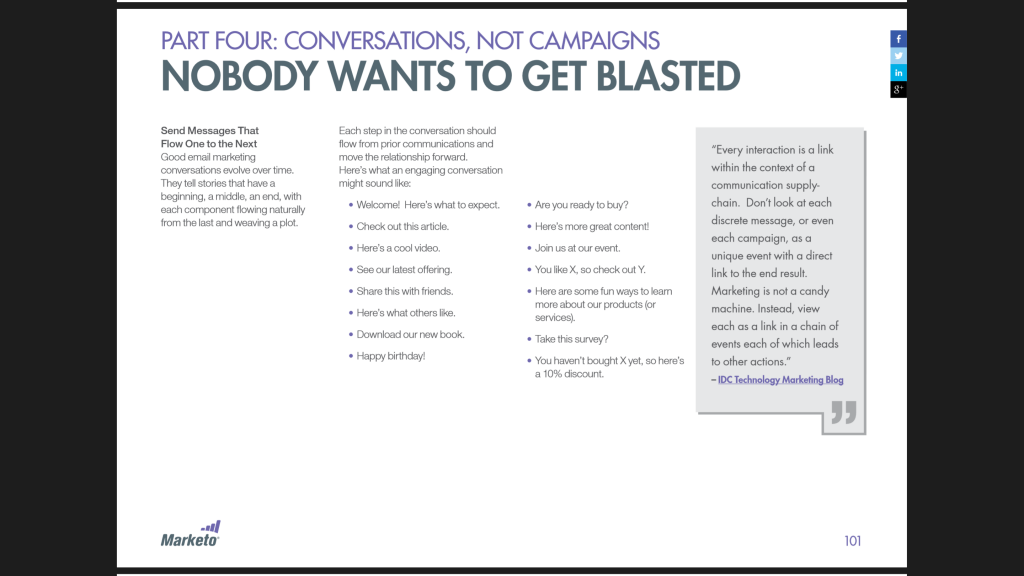
Now that you have the right structure you’re going to want to automate this entire campaign. What you’re going to do is use Mailchimp and create a workflow based on someone joining a list. Wherever you’re pushing your new leads, you’ll want to use that list for this initial workflow. Once you’ve done this, you’ve officially created an automated marketing workflow. This will ensure that all leads that you generate from your welcome mat will be nurtured all the way to the purchasing decision.
How to Make Your Startup Website in Less Than 10 Hours
You have your business, you have your team and have your product or service, but what you don’t have is a lot of time. That’s why building a website can be a big deal to a lot of startups and growing businesses. If you don’t know what you’re doing, it can go horribly wrong. The right website will be an asset to your sales and the seriousness with which VCs will consider your company. By designing a sleek, user-friendly website, you can leverage a great user experience to convert visitors into customers, investors and brand evangelists.
On the other hand, having a website with a clunky or confusing design will have visitors running away and VCs putting away their checkbooks. Standards for what a website "should" look like will vary by industry, as will the functional components of the web page, but the last place that your website "should" be, is a mile behind a direct competitor. You want a website that entices interest in your company and your product, not one that provides users with a memorably frustrating experience.
Basically, trying to launch your startup without the right website is like trying to run a marathon in a pair of worn out sneakers...and then going directly into to a job interview. Maybe technically possible to pull off, but definitely not likely.
It's important to have a functional, appealing website, but it is far from impossible to create one. You need a website that investors, clients and customers love. To achieve this, all you need to do is read this article and then devote some time to building a website that will complement your company.
So what if you’re not a master designer or a black belt in engineering? These days, all you need is a general idea and you quickly put together a beautiful website that will have everyone throwing wads of cash at your business. The key thing here is to not get overwhelmed. Your startup website may seem like a big deal, but getting something created and live in under 10 hours is entirely possible.
I recommend using Wordpress as your CMS, and will be showing you how to get a website up in 6 hours by using Wordpress.
How to Design a Website In Under 10 Hours
No Design Experience Needed
Step 1: Evaluate Competitors
The first step is an easy one. Start by looking at your top 5 competitors. See how their websites look, and determine what you like and dislike.Things to look for:
What is their key messaging?
What kind of imagery do they use?
What do you think could be improved?
Have you answered all of those questions? Congratulations you’re now an unofficial website critic. Use this information to determine what your website needs in order to both keep-up-with and stand-out-from the competition.
Estimated Time to complete: 45 minutes
Step 2: Initial Website Design Specifications
If your just read this headline and want argue with me or click away, don't do it! Well, we can still argue about it, but hear me out first.
The primary reason why web design projects fail or take longer than needed is because business owners are convinced they need a page for everything. The problem with creating several pages is that it creates a cluster**** to navigate and visitors can drop out before they reach the end of your conversion funnel. I always try to consolidate as many pages as I can initially, and then, as it makes sense, build pages out after the initial launch is complete.
However, if you’re trying to get a functional website live for your startup, there’s three key components that you need, and everything else can be built in later or tossed aside.
1) A Home Page
2) A Form
3) A Blog
What this format lets you do is build a website with the right functionality, as quickly as possible. As a startup or growing business, you need to move and move fast. Getting something that is functional as soon as possible is a must for any fledgling company, especially one that will depend on VC interest.
What I always recommend in these situations is to get a long home page, a form integrated (to collect leads), and a blog (to build traffic). Now some businesses will differ, in that they need a pricing page with checkout functionality, and this will affect your decision making process in the next steps.
Questions You Should Ask Yourself
What messaging is required to display the benefits of your product or service?
How many features do you want to highlight?
What are the key benefits you want to highlight?
What what information do visitors need in order to make a purchasing decision or inquiry?
What imagery is necessary to convey my product or service?
Do I need pricing and checkout pages?
During this phase you’ll want to look at website like Onepagelove.com (https://onepagelove.com/).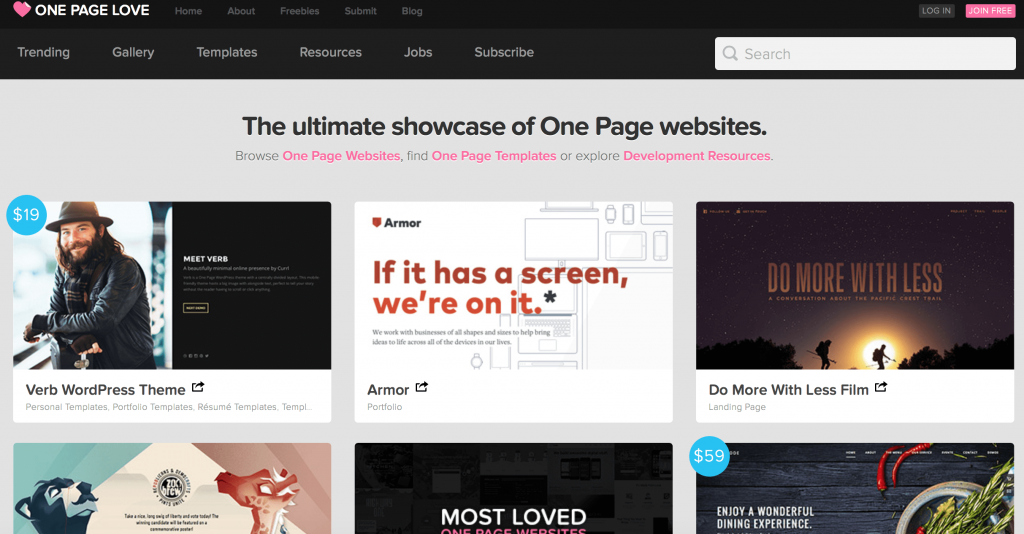
They provide great one page templates, and also google "Best Website Templates for Startups". This will provide a number of top 50 lists of templates that may be a good fit for what you need.
As you go through these templates, visualize where you would place your features, benefits, customer testimonials (if you have them), and any other information you had in mind. Typically, this is the information that you need to convert a visitor.
1) Features - What your product or service does.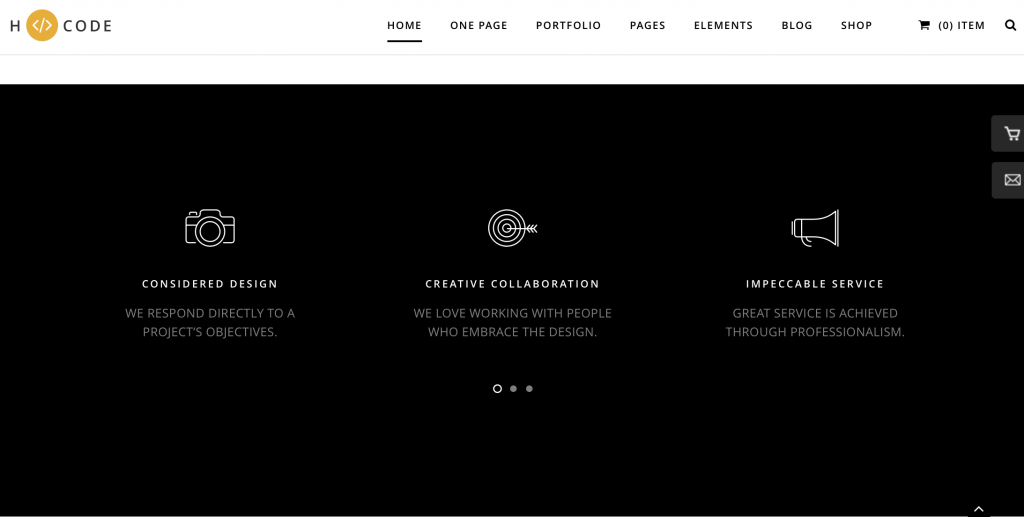
2) Benefits - The pain points that your product solves.
3) Images - Screenshots or images that convey the value of your product.
4) Testimonials - Customer testimonials to validate your product (if you have them).
5) Form - To convert visitors to leads.
6) About - Who you are, what your company does.
7) Pricing - How much your product/service costs, if applicable.
Keep in mind that no template will be exactly what you want. You’re looking for the best fit website in terms of making it easy to add your content to the template. This will also help you determine which features and benefits you think are the most important, as you’ll quickly find out that you’re going to have to sacrifice some to make the template work.
Once you’ve picked out a template that will be able to house all the information you need, then go ahead and buy it. Make sure that the website is responsive and that it comes with Wordpress templates, and demo content.
Estimated time to complete: 3 hours
Cost: $50-200 (depending on template)
Step 3: Implementing Your Template
Have you bought your domain name already? Your domain name is your website address. So, www.myawesomewebsite.com, would be your domain name. If not, then go to GoDaddy.com and purchase your domain name.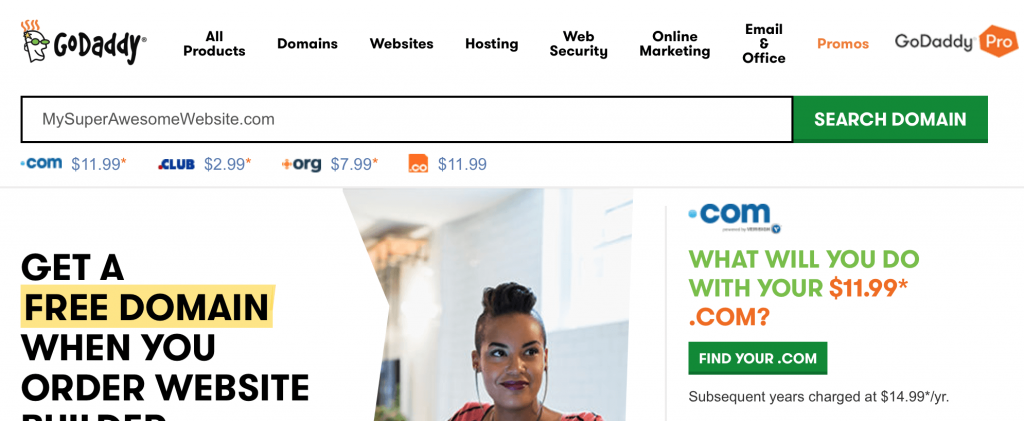
Next, you’ll want to add Wordpress to your new domain name. This is as simple as clicking install from the GoDaddy Admin. You can see a step-by-step guide from GoDaddy here.
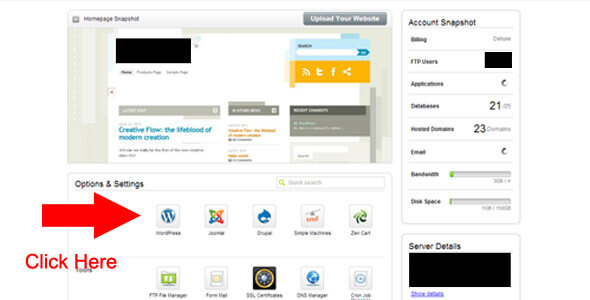
Once you’ve installed Wordpress to your GoDaddy account, you’ll be given a Wordpress Admin Login. You’ll want to login and go to "Appearance > Themes > Install Themes." Here you’re going to upload the zip file from your newly purchased Wordpress template.
Next, you’ll want to make sure you upload the Demo Content that comes with your theme. This ensures that what you saw when you were previewing the theme is automatically loaded onto your domain.
Estimated Time: 30-40 minutes
Step 4: Set Your Homepage
Quickly set your homepage by selecting "Customize" and setting a static homepage. Choose whatever page from the drop down that you’d like to be your homepage.Estimated time: 2 minutes (depending on internet connection).
Step 5: Replace all Content And Images
Now that you have your template loaded and the homepage selected, go in and begin editing the content. Because you've gathered the images, testimonials and other collateral that you need, adding in your content is as simple as find and replace. For each area with demo content, begin replacing this content with your company's words and images.To make this go as smoothly as possible, make sure that your images are the same size as the images that you will be replacing. If you have pricing pages and checkout pages, there’s going to be a little more work for you to do, but nothing should be taking you by surprise at this point.
Estimated time: 2-4 hours
Step 6: Plugins
To maximize your ability to build traffic, I recommend adding in the Yoast SEO plugin. I’ve always found that it’s the most effective and easiest to use. Also, some checkout processes will require you to install plugins, and integrations with CRMs may require them as well.Step 7: What’s next?
So, you built your website in about 6 hours. I bet you’re proud right? Well, don’t get too excited because the fun doesn’t stop now. It’s time to think of the next steps in your overall marketing plan.Think of your website as an iterative process, and spending these hours putting it together isn’t the end. You’ve just opened up yourself a can of worms, as the greatest benefits to the success of your website will come through painstakingly testing your website's content and copy. You’ll want to evaluate the success of your website using different messaging on the homepage through A|B tests (you can use tools like Optimizely to do this). You'll also evaluate the need for sub pages containing various features or resources, and leveraging your online traffic to reach marketing and sales goals.
Why your blog matters.
Besides A/B testing your website, one of the major next steps in creating a successful website is managing a successful blog. To some a blog may seem unnecessary, but it’s critical in getting your content strategy together. Even if you're just blogging a few times a month, this helps you to increase the amount of visitors to your website, and help build it’s online presence for the long haul.
Your blog will also be where interested investors, potential customers and even potential employees will go in order to learn some more about your company. By discussing the latest industry trends on your blog as well as company initiatives, your company will be visible as disruptive, viable and in-touch with the latest trends in your industry.
By following the steps in this article, you can turn an otherwise uneventful afternoon into a new company website. Though simply creating the website is half the battle, having an attractive, functional and reliable website will have a great number of positive benefits on your company. Through continuous evaluation of your company's needs and how your website is helping to meet those needs, your startup will be able to conduct business, engage with customers and attract the right sort of attention from investors.
Writing a Good Job Description for your Startup Business
Writing a job description to fill a role at your startup may seem easy enough — copy, cut and paste someone else’s job description. But these days it takes a little more than that. In a candidate-driven market, which is fancy speak meaning candidates pretty much choose from multiple offers, it becomes less about lists of qualifications and more about advertising your company and brand. As a startup business, whether you’re in software, services, or whatever, you’re going to be battling against the likes of Apple, Google, Facebook and the flavor of the month. It’s not easy to compete against those brand names, especially if you’re providing a software product in a highly specialized niche. Most candidates want to work for the big boys, not go up against them. Which is why showing off your brand and personality is more important than ever.
Tips for Writing a Good Job Description
As I mentioned before, several startups see the way that larger businesses write their job descriptions and think that copying is the way to go. Granted, some companies like Apple and Disney do an awesome job with theirs, but other industry players go the traditional route. This is not what you want to do.Recently, we were in the process of hiring, and despite knowing better we copied and pasted a generic job description for the sake of saving ourselves a half hour. LOL. This did’t work out too well for us. Within 14 days we had a total of about 6 applicants, each one worse than the one before. And statistically speaking, within 14 days is when you should see your highest candidate flow, after that there’s significant drop off. If you think of it in terms of marketing, job descriptions are similar to pay-per-click ads and SEO rankings (you’ll find us tie several things back to marketing). Just like with SEO and PPC ads you’ll find drop off rates get significant as your ranking diminishes, which is why there are tricks to optimizing your job description to increase the length of time you spend at the top.
Tips for writing better job descriptions
- Use a clear descriptive job title (none of that Sales Ninja-Starfighter-Bandit-Rockstar crap). You choose a title based on keywords that will be searched. If somebody is looking for a job as a “Sales Manager”, then they’re going to search that, not "10th Degree Sales Zen Master of Closing”
- Use your title and associated keywords in the copy. This is as simple as restating the Job Title in your job description, as well as a couple other keywords. If you’re looking for a “Sales Manager”, you may also want to include a couple instances of “inbound sales” or “outbound sales” in the job description to increase your relevancy for those keywords.
- This is the most important tip that I have. Focus on your employer branding and company messaging, and not on the roles and qualifications. Most businesses will write a job description with a 1000 words for the qualifications and role, but only use 100 words to describe the company and leverage their brand. I’ll expand on the importance of this.
Focus on Your brand not on the roles/qualifications of your job description
Unless you’re fresh on the job market, you should know what your job is. If somebody puts out a position for a VP of Sales, then you should be able to sum up the qualifications in a few bullet points just to weed out unfit candidates. And if I were a candidate for a VP of Sales role, then I should know what my position entails. Back to my point. We ran an impromptu experiment for our job description, the first of which brought in 6 candidates. Here’s our initial job description.
Sales Manager
We currently have an opportunity available for a Sales Manager at our digital marketing agency.
As our Sales Manager, you will manage leads and be responsible for customer service and satisfaction, prospecting, product knowledge, sales presentations, closing business, determining pricing and terms, paperwork, and sales guideline interpretation.
Responsibilities of a Sales Manager include:
Coach and mentor future sales associates to manage leads and train the team on customer service and satisfaction, prospecting, product knowledge, sales presentations, closing skills, product/service pricing, terms, paperwork, and interpreting sales guidelines
- Manage Sales Professionals, including motivating Sales Teams to become highly productive in a professional environment.
- Recruit, hire, train, and motivate Sales team.
- Provide Sales team with proper training regarding sales techniques, legal requirements, and company products, policies, and procedures.
- Review and evaluate sales performance.
- Conduct weekly sales meetings, projections and targets.
- Ensure that location sales quotas are achieved and promote sales activities.
- Ensure all contracts and paperwork is completed and returned accurately and in a timely manner.
- Conduct online demonstrations and leverage web-based tools to convert leads to customers.
- Provide input regarding property and merchandise selection and pricing by interacting with families.
- Be an advocate of Company initiatives.
- Handle personnel issues concerning the Sales Team.
- Foster and maintain a positive working environment.
- Develop positive relationships with startups and mid sized software and service businesses.
- Ability to motivate individuals with excellent communication skills, incredible relationship-building abilities, and a natural talent to lead.
- Minimum of 3-5 years of Sales Management experience preferred.
- Prior Sales experience required in a related or similar industry.
- Basic computer and technology skills required.
- Proficiency with Microsoft Office applications.
- Excellent understanding of the selling process.
- Time management and organizational skills.
- Proven Sales Team leadership in a quota-driven environment.
- Outstanding verbal and written communication skills.
- Ability to work in a team environment.
- Creative and detail-oriented
Notice how boring that is? Reading that again makes me want to slowly remove my eyeballs with a spoon. Yeesh. Since we didn’t get any candidates we thought were a good fit, we rewrote the job description. Naturally, we focused more on our brand, using language that we would use, and relaunched. Here’s an example of what we wrote.
Sales Manager
Do You Have the Right Stuff?We’re a highly focused digital marketing agency that works with several game-changing startups and larger more established and boring big businesses (just kidding! we love them too!!!). Our clients expect us to think outside the box and provide solutions that help break revenue and traffic targets, and that’s what we expect from you. We’re Digital Astronauts, pioneers of the marketing frontier, and we’re looking for a Sales Manager who’s eager to learn about several businesses and industries, and run our sales like it’s your very own Millennium Falcon.
You’ll be willing to flip, turn, spin, and even go through wormholes to close deals. We don’t give up and we don’t set boundaries for you, this is your starship and we’ll let you navigate. Your reward? Besides a healthy compensation package, you’ll be able to work remotely, and partake in Chimichanga tuesdays (we literally mail you a package of chimichangas every week. Yes, this is a real thing.).
What You’ll Do As Our Sales Manager
Sell the shit out of our services. Duh.
Qualifications for our Sales Manager
- Minimum 3 years sales experience.
- Understanding of Sales cycle from lead to close.
- Successful track record in selling things.
- Must be fan of Star Wars.
Obviously these two job descriptions are completely different from one another, and the difference in performance was amazing. The first job description gave us 6 candidates, and this one landed us a whopping 35 qualified candidates. The best part was hearing each candidates responses to our job opening and how they tailored cover letters to include Star Wars related humor and references towards chimichangas.
To cut through all the noise out there from generic job descriptions, you have to show a little personality, and the best way to find candidates that are a cultural fit for your business is to show off what makes you unique. Even if it is something as ridiculous as Chimichanga Tuesdays, or your company is composed of nerds. We may not be able to compete with the perks that Netflix or Google offer, but your startup is special and it’s key for you to write your job description in a way that lets candidates know it is too.










